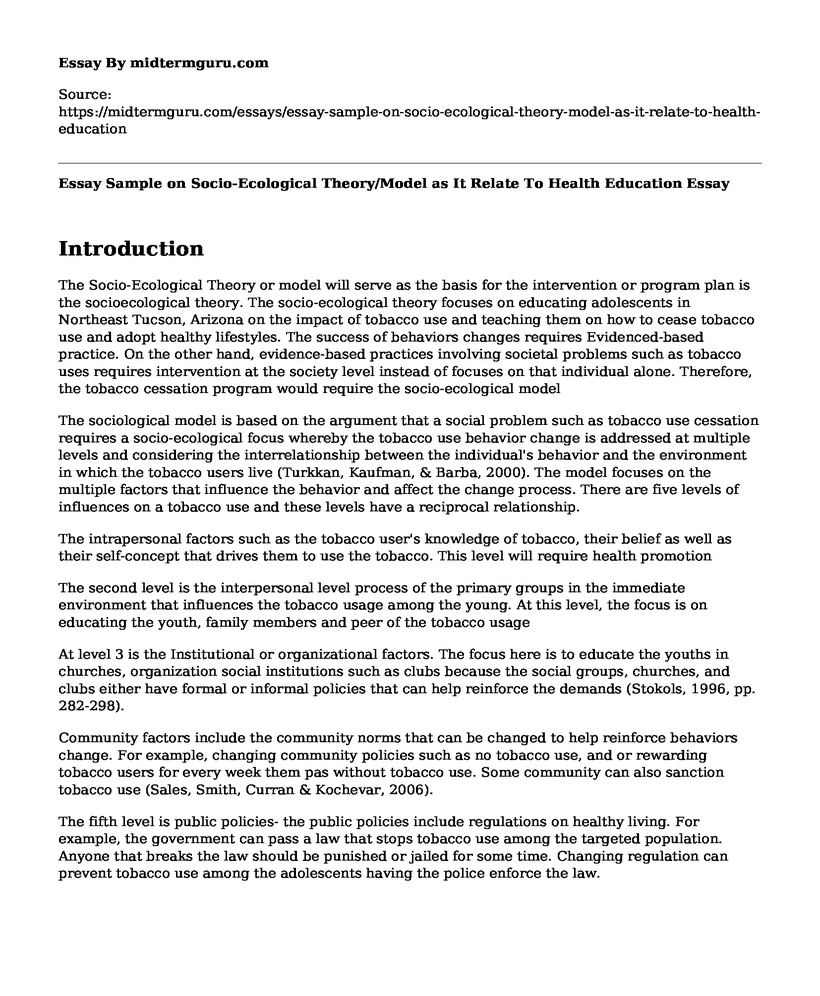Introduction
The Socio-Ecological Theory or model will serve as the basis for the intervention or program plan is the socioecological theory. The socio-ecological theory focuses on educating adolescents in Northeast Tucson, Arizona on the impact of tobacco use and teaching them on how to cease tobacco use and adopt healthy lifestyles. The success of behaviors changes requires Evidenced-based practice. On the other hand, evidence-based practices involving societal problems such as tobacco uses requires intervention at the society level instead of focuses on that individual alone. Therefore, the tobacco cessation program would require the socio-ecological model
The sociological model is based on the argument that a social problem such as tobacco use cessation requires a socio-ecological focus whereby the tobacco use behavior change is addressed at multiple levels and considering the interrelationship between the individual's behavior and the environment in which the tobacco users live (Turkkan, Kaufman, & Barba, 2000). The model focuses on the multiple factors that influence the behavior and affect the change process. There are five levels of influences on a tobacco use and these levels have a reciprocal relationship.
The intrapersonal factors such as the tobacco user's knowledge of tobacco, their belief as well as their self-concept that drives them to use the tobacco. This level will require health promotion
The second level is the interpersonal level process of the primary groups in the immediate environment that influences the tobacco usage among the young. At this level, the focus is on educating the youth, family members and peer of the tobacco usage
At level 3 is the Institutional or organizational factors. The focus here is to educate the youths in churches, organization social institutions such as clubs because the social groups, churches, and clubs either have formal or informal policies that can help reinforce the demands (Stokols, 1996, pp. 282-298).
Community factors include the community norms that can be changed to help reinforce behaviors change. For example, changing community policies such as no tobacco use, and or rewarding tobacco users for every week them pas without tobacco use. Some community can also sanction tobacco use (Sales, Smith, Curran & Kochevar, 2006).
The fifth level is public policies- the public policies include regulations on healthy living. For example, the government can pass a law that stops tobacco use among the targeted population. Anyone that breaks the law should be punished or jailed for some time. Changing regulation can prevent tobacco use among the adolescents having the police enforce the law.
How the Model Will Guide the Planning for Each of the Program Components
Based on the socioecological model, an adolescent's tobacco use behavior is influenced by their family member, their peer, the society as well as the socio groups. Therefore, educating the individual alone to change his behaviors would not help in helping heir change their behavior. Instead of focusing on the individual, the model proposes that the socio-ecological change is important (Zhang et al., 2015). To develop an effective tobacco use cessation programs, it is important for the planner to understand the policies, beliefs, norms, goals, structures as well as behaviors that include or support tobacco use and change these factors at all level: personal, interpersonal, institutional level, community level, and the public or state level. Even though the individual lifestyles factors will be considered, the model encourages intervention groups to enforce factors where the adolescent lives, play, socializes and if possible amend laws to deter tobacco use. Programs will be evaluated based on the rate of reduced purchases, reduction in the number of offenders as well as behavior changes among the nicotine users.
References
Turkkan, S., Kaufman, N., & Barba, J. (2000). Transdisciplinary Tobacco Use Research Centers: A model collaboration between public and private sectors. Nicotine & Tobacco Research, 2(1), 9-13. doi: 10.1080/14622200050011259
Sales, A., Smith, J., Curran, G., & Kochevar, L. (2006). Models, Strategies, and Tools. Journal Of General Internal Medicine, 21(S2), S43-S49. doi: 10.1111/j.1525-1497.2006.00362.x
Zhang, S., Wei, Z., Liu, W., Yao, L., Suo, W., & Xing, J. et al. (2015). Indicators for Environment Health Risk Assessment in the Jiangsu Province of China. International Journal Of Environmental Research And Public Health, 12(9), 11012-11024. doi: 10.3390/ijerph120911012
Stokols, D. (1996). Translating social ecological theory into guidelines for community healthpromotion. American Journal of Health Promotion, 10(4), 282-298
Cite this page
Essay Sample on Socio-Ecological Theory/Model as It Relate To Health Education. (2022, Oct 24). Retrieved from https://midtermguru.com/essays/essay-sample-on-socio-ecological-theory-model-as-it-relate-to-health-education
If you are the original author of this essay and no longer wish to have it published on the midtermguru.com website, please click below to request its removal:
- Marriages and Families: Historical Analysis Example
- Essay Sample on Social Hierarchy and Power
- The Development of Buddhism and Its Influence on Vietnamese Society Throughout History
- Essay on Changing Social Class
- Organizational Training: Enhancing Employee Development & Performance - Essay Sample
- Gender Stereotyping: Common Practice, Devastating Impact - Essay Sample
- Nike's Ethical Dilemma: Using Image of Black Man in Campaign - Essay Sample







